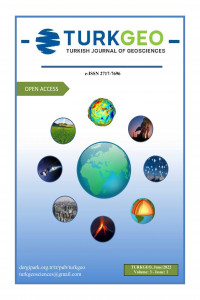Öz
Kaynakça
- Alkan, N., & Karamanoğlu, Y.E. (2020). Öngörüye dayalı kolluk temelinde önleyici kolluk: Rusya Federasyonu’ndan örnekler. Güvenlik Bilimleri Dergisi, 9(2), 387-418 (in Turkish).
- Arık, G. (2019). A technology acceptance model suggestion for public order services and the effect of case-based training on technology acceptance (PhD thesis). Hacettepe University, Ankara, Turkey (in Turkish).
- Başkaya, O., Ağaçsapan, B., & Çabuk, A. (2020). Akıllı şehirler kapsamında yapay zekâ teknikleri kullanarak etkin ulaşım planlarının oluşturulması üzerine bir model önerisi. GSI Journals Serie C: Advancements in Information Sciences and Technologies, 3(1), 1-21.
- Dalan, Ö. (2015). Intelligent geographical ınformation system for criminology (PhD thesis). Dokuz Eylül University, İzmir, Turkey.
- Phiri, J., & Lubobyai, C.S. (2020). Crime mapping model based on cloud and spatial data: a case study of Zambia police service. International Journal of Advanced Computer Science and Applications, 11(1), 251-265.
- Kanlı İ.B., & Kaplan, B. (2018). Kentsel güvenliğin sürdürülebilirliğinde ileri teknolojilerin kullanılması: Coğrafi Bilgi Sistemleri. TESAM Akademi Dergisi, 143-186.
- Maghanoy, J.A.W. (2017). Crime mapping report mobile application using GIS. IEEE 2nd International Conference on Signal and Image Processing (ICSIP), 247-251.
- Rich, T.F. (1995). The use of computerized mapping in crime control and prevention programs, 2, 2. US Department of Justice, Office of Justice Programs, National Institute of Justice.
- Sarı, G., & Özgür, E. (2019). Kamu alanında güvenlik ve emniyet algısı. 13. Uluslararası Kamu Yönetimi Sempozyumu, Gaziantep Üniversitesi.
- Wartell, J. (2011). Independent Adviser on Public Safety, GIS for Proactive Policing and Crime Analysis, Presentation at the Technologies for Critical Infrastructure Protection Conference, National Harbor.
- Wartell, J. (2001). Privacy in the information age: a guide for sharing crime maps and spatial data. US Department of Justice, Office of Justice Programs, National Institute of Justice.
- Yong, S. (2015). Disclosure of crime map., http://www.iolaw.org.cn/showNews.aspx?id=50993 (last accessed 18 June 2021)
- Url-1: https://kknews.cc/zh-hk/news/9j6ve8q.html (last accessed 15 Nov 2021)
- Url-2: https://www.redandblack.com/cops/maps/athens-crime-map-july-22---28/article_c35efb04-f874-11e2-9163-0019bb30f31a.html (last accessed 15 Nov 2021)
- Url-3: http://www.safemap.go.kr/main/smap.do?flag=2 (last accessed 27 Dec 2021)
- Url-4: http://www2.wagmap.jp/jouhomap-sp/) (last accessed 21 Dec 2021)
- Url-5: https://www.refcrime.info/de/verbrechen/karte (last accessed 27 June 2021)
- Url-6: http://crimestat.ru/offenses_map (last accessed 12 Nov 2021)
Öz
In the dynamic structure of the 21st century, the fight against crime is of increasing interest to the whole society. Law enforcement agencies use crime maps in order to analyze all components of the crime and see them in a single window to develop various scientific strategies. Crime maps that have been used actively for the last 70 years have been given different capabilities with the recent developments in geographic information systems (GIS). In this way, effective crime analyzes can be made, crime prevention tactics and strategies can be developed. Crime information systems, which make it easier to see the events at the desired scale and make quick decisions, are actively used by every law enforcement unit. In some developed countries, crime maps are available to citizens. In our country, a study based on the general framework of a web-based crime information system was carried out with the survey method, which included expectations from the crime map on an international scale. The survey conducted with military personnel of NATO members concluded that a significant majority of respondents were concerned with crime maps and believed that crime maps should be made available to all citizens.
Anahtar Kelimeler
Web-based crime map GIS Crime analysis Crime Prevention Criminology
Kaynakça
- Alkan, N., & Karamanoğlu, Y.E. (2020). Öngörüye dayalı kolluk temelinde önleyici kolluk: Rusya Federasyonu’ndan örnekler. Güvenlik Bilimleri Dergisi, 9(2), 387-418 (in Turkish).
- Arık, G. (2019). A technology acceptance model suggestion for public order services and the effect of case-based training on technology acceptance (PhD thesis). Hacettepe University, Ankara, Turkey (in Turkish).
- Başkaya, O., Ağaçsapan, B., & Çabuk, A. (2020). Akıllı şehirler kapsamında yapay zekâ teknikleri kullanarak etkin ulaşım planlarının oluşturulması üzerine bir model önerisi. GSI Journals Serie C: Advancements in Information Sciences and Technologies, 3(1), 1-21.
- Dalan, Ö. (2015). Intelligent geographical ınformation system for criminology (PhD thesis). Dokuz Eylül University, İzmir, Turkey.
- Phiri, J., & Lubobyai, C.S. (2020). Crime mapping model based on cloud and spatial data: a case study of Zambia police service. International Journal of Advanced Computer Science and Applications, 11(1), 251-265.
- Kanlı İ.B., & Kaplan, B. (2018). Kentsel güvenliğin sürdürülebilirliğinde ileri teknolojilerin kullanılması: Coğrafi Bilgi Sistemleri. TESAM Akademi Dergisi, 143-186.
- Maghanoy, J.A.W. (2017). Crime mapping report mobile application using GIS. IEEE 2nd International Conference on Signal and Image Processing (ICSIP), 247-251.
- Rich, T.F. (1995). The use of computerized mapping in crime control and prevention programs, 2, 2. US Department of Justice, Office of Justice Programs, National Institute of Justice.
- Sarı, G., & Özgür, E. (2019). Kamu alanında güvenlik ve emniyet algısı. 13. Uluslararası Kamu Yönetimi Sempozyumu, Gaziantep Üniversitesi.
- Wartell, J. (2011). Independent Adviser on Public Safety, GIS for Proactive Policing and Crime Analysis, Presentation at the Technologies for Critical Infrastructure Protection Conference, National Harbor.
- Wartell, J. (2001). Privacy in the information age: a guide for sharing crime maps and spatial data. US Department of Justice, Office of Justice Programs, National Institute of Justice.
- Yong, S. (2015). Disclosure of crime map., http://www.iolaw.org.cn/showNews.aspx?id=50993 (last accessed 18 June 2021)
- Url-1: https://kknews.cc/zh-hk/news/9j6ve8q.html (last accessed 15 Nov 2021)
- Url-2: https://www.redandblack.com/cops/maps/athens-crime-map-july-22---28/article_c35efb04-f874-11e2-9163-0019bb30f31a.html (last accessed 15 Nov 2021)
- Url-3: http://www.safemap.go.kr/main/smap.do?flag=2 (last accessed 27 Dec 2021)
- Url-4: http://www2.wagmap.jp/jouhomap-sp/) (last accessed 21 Dec 2021)
- Url-5: https://www.refcrime.info/de/verbrechen/karte (last accessed 27 June 2021)
- Url-6: http://crimestat.ru/offenses_map (last accessed 12 Nov 2021)
Ayrıntılar
| Birincil Dil | İngilizce |
|---|---|
| Konular | Yer Bilimleri ve Jeoloji Mühendisliği (Diğer) |
| Bölüm | Research Articles |
| Yazarlar | |
| Yayımlanma Tarihi | 28 Haziran 2022 |
| Gönderilme Tarihi | 17 Ocak 2022 |
| Kabul Tarihi | 16 Mart 2022 |
| Yayımlandığı Sayı | Yıl 2022 Cilt: 3 Sayı: 1 |


